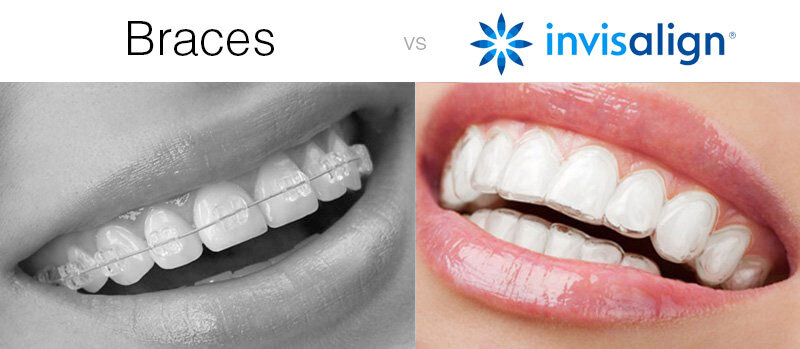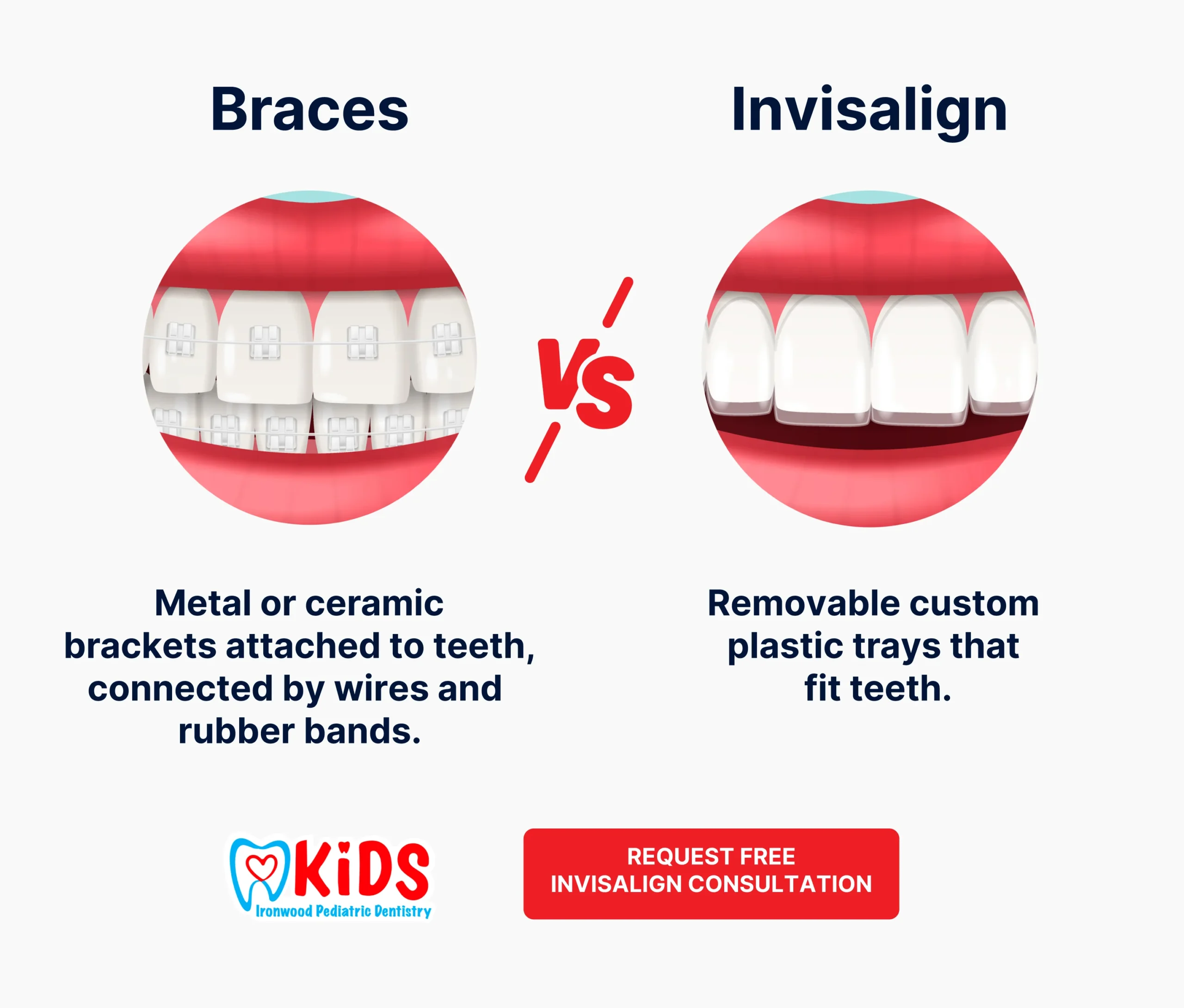Frequently Asked Questions Concerning Invisalign: Everything You Required to Know
Frequently Asked Questions Concerning Invisalign: Everything You Required to Know
Blog Article
Invisalign vs. Standard Dental braces: Which Choice Is Right for You?
When taking into consideration orthodontic therapy, the selection between Invisalign and typical braces provides several essential factors that warrant mindful assessment. Invisalign offers a discreet choice with detachable aligners, while traditional dental braces provide a much more visible yet reliable option for severe misalignment. Each option encompasses unique benefits and drawbacks associated with appearances, convenience, therapy period, and price. Recognizing these subtleties is crucial for making a notified decision that aligns with your personal choices and way of living. The question remains: which option will best fulfill your orthodontic demands and assumptions?
Overview of Therapy Choices

On the other hand, standard braces consist of steel brackets and cables that are adhered to the teeth. This method applies continual pressure gradually to achieve positioning. While reliable for complicated orthodontic problems, typical braces require regular check outs for adjustments and can pose challenges in keeping dental hygiene because of the trouble of cleaning around cords and braces.
Both alternatives have their advantages, and the selection often depends upon particular dental problems, way of life choices, and person conformity. Ultimately, seeking advice from an orthodontic specialist is crucial for identifying the most suitable treatment plan tailored to individual needs. Understanding the nuances of each choice can substantially influence the overall success of orthodontic therapy.
Aesthetic Factors To Consider
A considerable element affecting the option between Invisalign and traditional dental braces is the aesthetic charm each treatment offers. Invisalign aligners are crafted from clear plastic, making them basically undetectable when worn.
In comparison, standard dental braces include steel brackets and wires, which can be a lot more visible. While advancements in orthodontic modern technology have actually caused the development of smaller sized brackets and tinted elastics, traditional dental braces still keep a more obvious profile. For some people, the visibility of dental braces might discourage them from looking for essential therapy.
Eventually, the choice in between Invisalign and traditional braces may depend upon personal choices regarding visual appeals. People who focus on discernment typically favor Invisalign, while those who are less worried regarding visibility may choose typical braces. Recognizing the visual implications of each option is important for making an educated decision that aligns with one's way of life and choices.
Convenience and Convenience

In terms of comfort, Invisalign aligners are detachable, making it possible for individuals to appreciate their favorite foods without constraint and preserve optimum oral health. Brushing and flossing are simplified, as the aligners can be obtained throughout these routines, whereas traditional braces call for mindful steering around braces and cables.
In comparison, conventional dental braces require normal adjustments, making them much less convenient for those with hectic timetables. In general, check my blog the convenience and convenience of Invisalign make it an enticing choice for numerous people seeking orthodontic treatment.
Therapy Period and Effectiveness
While both Invisalign and typical braces are reliable in fixing dental misalignments, the period of treatment can differ dramatically between the 2 options. Generally, Invisalign therapy can take anywhere from 12 to 18 months, relying on the complexity of the instance. The clear aligners work by gradually changing teeth into their wanted positions, and normal follow-ups with an orthodontist assistance make sure progression continues to be on track.
On the other hand, typical dental braces often require a longer commitment, generally varying from 18 months to 3 years. This is due to their set nature and the usage of cables and braces, which can be extra efficient for intricate instances and severe imbalances (Invisalign). The treatment efficiency of typical braces is well-documented, as they enable for precise modifications and better control over tooth activity
Inevitably, the selection between Invisalign and conventional braces may depend upon both the anticipated treatment duration and the particular dental issues at hand. Consulting with an orthodontist is vital, as they can give customized recommendations based on private requirements, making sure the selected technique aligns with desired durations and results.
Cost Contrast and Insurance Policy Choices
Cost plays a significant role in the decision-making procedure for individuals considering orthodontic therapy, whether going with Invisalign or conventional dental braces. Usually, the price of Invisalign arrays from $3,000 to $8,000, while conventional braces commonly set you back click here for more between $2,000 and $6,000. Aspects influencing these prices include the intricacy of the instance, the duration of treatment, and geographical area.
Several dental insurance coverage strategies provide partial protection for orthodontic therapies, yet the specifics can differ commonly. Usually, traditional braces may be extra regularly covered by insurance plans compared to Invisalign, which some insurance companies classify as an aesthetic procedure.
Additionally, a number of orthodontic methods supply adaptable layaway plan, making both treatment choices a lot more obtainable. Patients should ask about possible financing options and discounts for upfront payments. Assessing the overall expense, including insurance policy advantages and layaway plan, is crucial for making an educated decision that aligns with both visual choices and budget factors to consider.

Verdict
In recap, the selection between Invisalign and traditional braces depends upon numerous variables, consisting of visual preferences, comfort, treatment period, and expense. Invisalign uses a discreet, removable option that facilitates dental health and dietary versatility, while standard dental braces may be better for intricate oral problems and frequently come at a reduced price factor. Inevitably, examination with an orthodontist is necessary to evaluate individual conditions and figure out the most appropriate treatment alternative for accomplishing ideal oral placement.
When thinking about orthodontic treatment, the selection between Invisalign and standard braces offers numerous essential variables that warrant careful analysis.Comparing Invisalign and typical dental braces exposes distinct therapy options for orthodontic improvement.While both Invisalign and traditional braces are reliable in remedying oral misalignments, the period of treatment can differ considerably in between the two choices.Cost plays a you can try here significant function in the decision-making procedure for people thinking about orthodontic therapy, whether choosing for Invisalign or typical braces.In recap, the selection in between Invisalign and conventional dental braces hinges on several variables, including visual choices, comfort, therapy duration, and expense.
Report this page